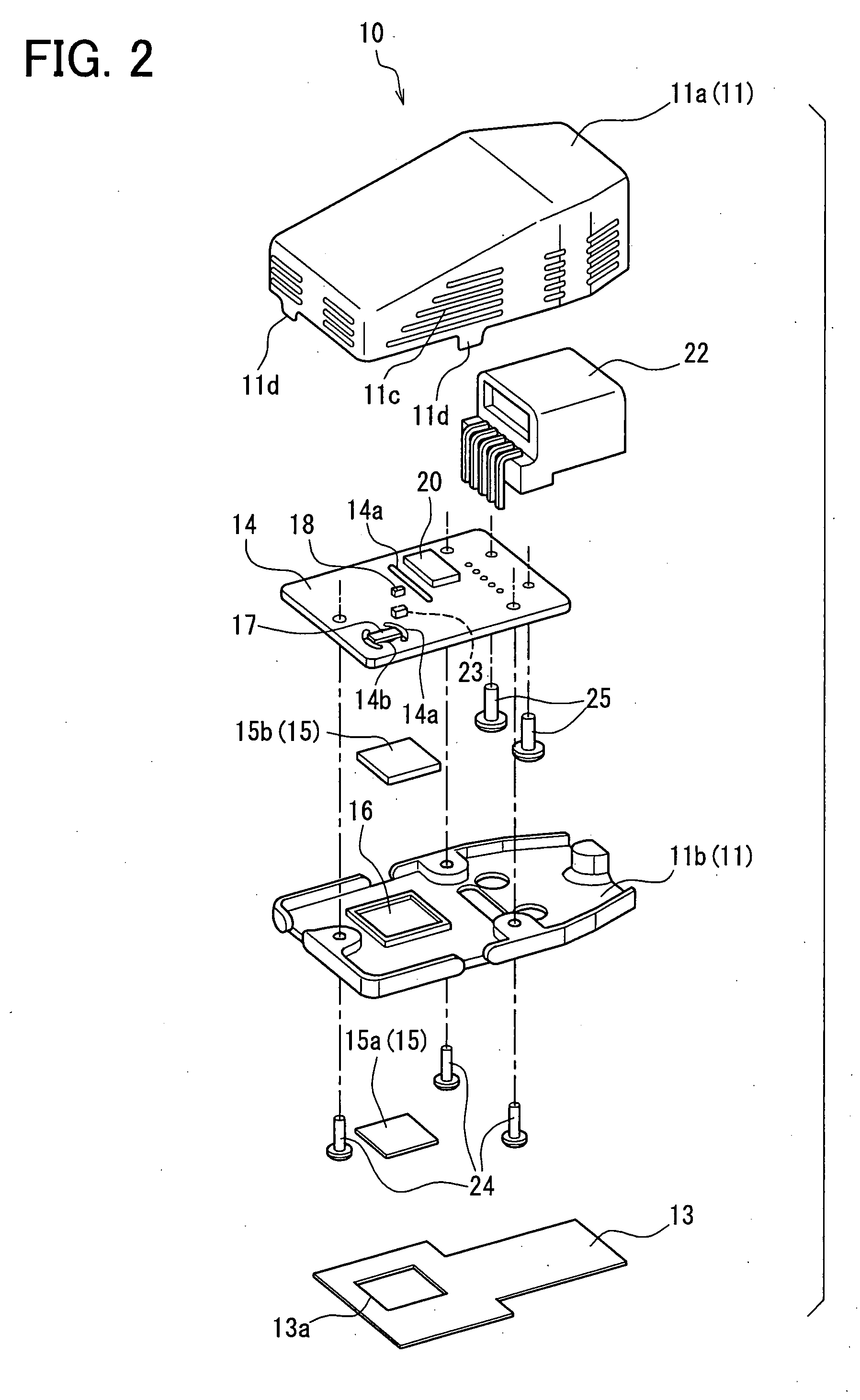Humidity detecting apparatus and vehicular air conditioner having the same
a technology of humidity detection and air conditioner, which is applied in the direction of humidity control, refrigeration components, digital computer details, etc., can solve the problems of increasing the cost of glass temperature detection except for contact detection using the temperature sensor, and the likely influence of glass temperature detection accuracy, so as to reduce ventilation heat loss, improve heat conduction, and accurately detect the effect of temperatur
- Summary
- Abstract
- Description
- Claims
- Application Information
AI Technical Summary
Benefits of technology
Problems solved by technology
Method used
Image
Examples
first embodiment
[0031]A first embodiment of the present invention will be described with reference to FIGS. 1 to 14. A humidity detecting apparatus 10 shown in FIGS. 1 and 2 is used, for example, for a vehicular air conditioner shown in FIG. 4.
[0032]First, a structure of the humidity detecting apparatus 10 will be described. As shown in FIGS. 1 and 2, the humidity detection apparatus 10 includes a case 11, which is, for example, made of a resin. The case 11 has a substantially flat, rectangular parallelepiped shape, and includes an upper case member 11a and a lower case member 11b. The upper case member 11a is formed with ventilation slits 11c on its side walls for allowing ambient air where the case 11 is disposed, such as air inside of a passenger compartment, to flow through the case 11.
[0033]The case 11 is fixed to an inner surface 12a of a window glass 12 of the vehicle through an adhesive sheet 13. For example, the window glass 12 is a front windshield of the vehicle, and the humidity detecti...
second embodiment
[0133]Next, a second embodiment of the present invention will be described with reference to FIG. 15. FIG. 15 shows a glass temperature detecting part of a humidity detecting apparatus 10 of the second embodiment. Hereafter, like components are denoted by like reference numerals as the first embodiment and a description thereof will not be repeated. Different structures and effects will be mainly described hereafter.
[0134]In the second embodiment, the glass temperature sensor 23 is not arranged on the circuit board 14 on which the humidity sensor 17 and the air temperature sensor 18 are mounted. As shown in FIG. 15, the glass temperature sensor 23 is connected to the circuit board 14 through electrically conductive members 23a.
[0135]For example, the metallic member 16 is divided into a first metallic part 16a and a second metallic part 16b. The glass temperature sensor 23 is arranged between the first metallic part 16a and the second metallic part 16b. The electrically conductive m...
third embodiment
[0139]Next, a third embodiment will be described with reference to FIG. 16. FIG. 16 shows a glass temperature detecting part of a humidity detecting apparatus 10 of the third embodiment. Hereafter, like components are denoted by like reference numerals as the first embodiment and a description thereof will not be repeated. Different structures and effects will be mainly described hereafter.
[0140]In the third embodiment, the glass temperature sensor 23 is arranged at a position separate from the circuit board 14 on which the humidity sensor 17 and the air temperature sensor 18 are mounted. As shown in FIG. 16, the glass-side heat conductive member 15a and the sensor-side heat conductive member 15b are disposed on the opposite sides of the metallic member 16. The sensor-side heat conductive member 15b has a thickness such that at least a temperature detecting portion of the glass temperature sensor 23 is embedded therein. For example, the sensor-side heat conductive member 15b is made...
PUM
 Login to View More
Login to View More Abstract
Description
Claims
Application Information
 Login to View More
Login to View More - R&D
- Intellectual Property
- Life Sciences
- Materials
- Tech Scout
- Unparalleled Data Quality
- Higher Quality Content
- 60% Fewer Hallucinations
Browse by: Latest US Patents, China's latest patents, Technical Efficacy Thesaurus, Application Domain, Technology Topic, Popular Technical Reports.
© 2025 PatSnap. All rights reserved.Legal|Privacy policy|Modern Slavery Act Transparency Statement|Sitemap|About US| Contact US: help@patsnap.com



